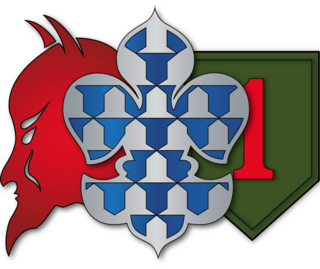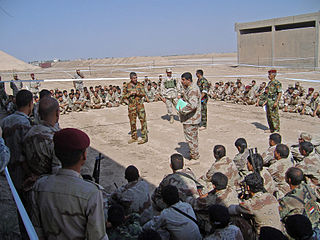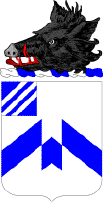
The 3rd Battalion, 16th Field Artillery Regiment is a field artillery battalion assigned to the 2nd Brigade Combat Team, 4th Infantry Division. Carrying the lineage of Battery C, 16th Field Artillery Regiment, the battalion carries campaign streamers from World War I, World War II, and Vietnam, and has served with the 4th Infantry Division and 8th Infantry Division. The unit's nickname is "Rolling Thunder", and their motto is "Macte Nova Virtute". The battalion is composed of a headquarters and headquarters battery (HHB), three cannon batteries, and has an attached Forward Support Company, Company F, 15th Brigade Support Battalion.

The Second Battle of Fallujah, initially codenamed Operation Phantom Fury, Operation al-Fajr was an American-led offensive of the Iraq War that began on 7 November 2004 and lasted about six weeks.

The 1st Armored Brigade Combat Team, 1st Infantry Division is a maneuver brigade combat team (BCT) in the United States Army. It is the oldest permanent brigade in the Army and has some of the oldest units in the United States Army. Headquarters and Headquarters Company (HHC), 1st Brigade served in World War I, Vietnam, Desert Shield and Desert Storm. Its most notable campaigns include the Aisne-Marne, Meuse-Argonne, Picardy, Tet Counteroffensive and the Liberation and Defense of Kuwait. Since Desert Storm, the "Devil Brigade" has deployed to Bosnia, Kuwait, and to Korea to participate in a 2nd Infantry Division exercise.

The 4th Brigade, 2nd Infantry Division ("Raiders") is an inactive Stryker Brigade Combat Team (SBCT) of the United States Army. The brigade was activated at Fort Lewis, Washington on 1 June 2006 by reflagging the 2nd Stryker Cavalry Regiment. The 4th Stryker Brigade had the distinction of being the last U.S. Army combat brigade to serve in support of Operation Iraqi Freedom. The brigade deployed three times in support of the War on Terror, to Iraq from 2007–2008 and from 2009–2010, and to Afghanistan from 2012–2013 before deactivating in March 2014.

The Second Battle of Ramadi was fought during the Iraq War from March 2006 to November 2006, for control of the capital of the Al Anbar Governorate in western Iraq. A joint US military force under the command 1st Brigade Combat Team, 1st Armored Division and Iraqi Security Forces fought insurgents for control of key locations in Ramadi. Coalition strategy relied on establishing a number of patrol bases called Combat Operation Posts throughout the city.
Al-Karmah, also sometimes transliterated as Karma, Karmah, or Garma, is a city in central Iraq, 16 km (10 mi) northeast of Fallujah in the province of Al Anbar.
An Operation Forsythe Park in Albu Bali, located 15 kilometers northeast of Ramadi, was completed on Wednesday 5 May 2007 in Ramadi, Iraq by approx 450 Iraqi Security and Coalition Forces.
Operation Able Rising Force was a military operation in December 2005 in Iraq by US troops and Iraqi police and troops for purposes of counterinsurgency to locate and detain suspected terrorists.

The Battle of Baqubah II took place during the Iraq War in the capital of the Iraqi province Diyala, to the north-east of Baghdad. It began in early March 2007, when U.S. and Iraqi forces commenced preliminary operations to "establish a presence in Diyala beyond their Forward Operating Base".

Operation Phantom Thunder began on 16 June 2007, when Multi-National Force-Iraq launched major offensive operations against al-Qaeda and other extremist terrorists operating throughout Iraq. It was the largest coordinated military operation since the 2003 invasion of Iraq. Operation Phantom Thunder was a corps level operation, including Operation Arrowhead Ripper in Diyala Province, Operation Marne Torch and Operation Commando Eagle in Babil Province, Operation Fardh al-Qanoon in Baghdad, Operation Alljah in Anbar Province, and continuing special forces actions against the Mahdi Army in southern Iraq and against Al-Qaeda leadership throughout the country. The operation was one of the biggest military operations in Iraq since the U.S. invasion in 2003.

Operation Commando Eagle was a 2007 military operation of the Iraq War. It began on 21 June 2007, when Iraqi and Coalition forces launched a combined ground and air assault operation against Islamic State of Iraq and other extremist terrorists operating in the Mahmudiyah region of Babil province. The action was intended to curb terrorist activity southwest of Baghdad through a mix of helicopter assaults and Humvee-mounted movements.

Operation Marne Torch refers to two operations launched by U.S.-led Coalition forces in 2007 against Islamic State of Iraq in the Arab Jabour area of Babil province. This campaign is named after Operation Torch, the joint US/British invasion of French North Africa in 1942, presumably because of the two operations' similar thrust into the enemies' southern underbellies.
Operation Sledgehammer (2007) was a military search operation during the 2003 Iraq war. The search was carried out in an attempt to disrupt militia influence and violence in the town of Jabella, Iraq 22 June 2007.
Operation Saber Guardian was a joint operation between 3rd Battalion, 3rd Brigade, 5th Iraqi Army soldiers, local concerned citizens, and 6-9 Armored Reconnaissance Squadron, 3rd Brigade Combat Team, 1st Cavalry Division. The operation, targeted at Islamic State of Iraq leadership near the town of Sherween, Iraq, resulted in 20 ISI terrorists killed, 20 detained, and two weapons caches and 12 improvised explosive devices discovered.
Without a single shot being fired, more than 3,000 members of the Iraqi security forces (ISF) and Bastogne Soldiers from the 1st Brigade Combat Team, 101st Airborne Division, detained 154 terror suspects and seized more than 350 semi-automatic and automatic rifles, a variety of pistols and mortar rounds, as well as a large number of materials used to make Improvised Explosive Devices (IED) during Operation Gaugamela (gaw'guh-MEE-luh), a search for suspected al-Qaeda terrorists in the cities and areas surrounding Hawija and Riyadh, just west of Kirkuk, Iraq.

Operation Phantom Strike was a major offensive launched by the Multi-National Corps – Iraq on 15 August 2007 in a crackdown to disrupt both the al-Qaeda-affiliated Islamic State of Iraq and Shia insurgent operations in Iraq. It consisted of a number of simultaneous operations throughout Iraq focused on pursuing remaining ISI terrorists and Iranian-supported insurgent groups. It was concluded in January 2008 and followed up with Operation Phantom Phoenix.

The 30th Infantry Regiment is a United States Army infantry regiment. Two battalions are currently active under the United States Army Regimental System; there is no active regimental headquarters, with regimental designation being used only for historical tradition.
Operation Phantom Phoenix was a major nationwide offensive launched by the Multinational Force Iraq (MNF-I) on 8 January 2008 in an attempt to build on the success of the two previous corps-level operations, Operation Phantom Thunder and Operation Phantom Strike and further reduce violence and secure Iraq's population, particularly in the capital Baghdad. The offensive consisted of a number of joint Coalition and Iraqi Army operations throughout northern Iraq as well as in the southern Baghdad Belts.
The Baghdad Belts are the residential, agricultural and industrial areas, as well as communications and transportation infrastructure that encircle the Iraqi capital and connect it to other areas in Iraq. In the Iraq War, they were used by insurgents as staging points for operations in the capital.

Operation Sayeed also known as Operation Hunter in English, was a series of operations conducted in western Al Anbar Governorate by the United States Marine Corps in 2005. It was an umbrella operation, consisting of at least 11 named operations between July 2005 to December 2005. The purpose was to drive Al-Qaeda in Iraq forces from the Western Euphrates River Valley. Some parts of Operation Sayeed were Operation Steel Curtain and Operation Iron Fist.










